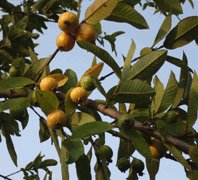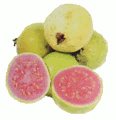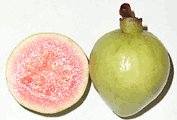Guava Nutrition facts
Guava is another tropical fruit rich in high-profile nutrients. With its unique flavor, taste, and health-promoting qualities, the fruit easily fits into the category of new functional foods, often labeled as “super-fruits.”
It is an evergreen, tropical shrub or small low-growing tree that probably originated in the central Americas. Guavas actually thrive well under both humid and dry climates and can tolerate brief periods of cold spells, but can only withstand a few degrees of frost. Its adaptability to ranging environments makes it a favorite commercial crop in some tropical areas.
Botanically, this wonderful fruit belongs to the family of Myrtaceae, of the genus: Psidium. Pineapple guava, rose apple and allspice are other closely related plants in the Myrtaceae family.
Scientific name: Psidium guajava.

|

|
| Ripe guava fruits on Psidium guajava tree. | Red varieties are indeed rich in carotenes and lycopene. |
During each season, a guava tree produces numerous round to ovoid or pear-shaped fruits, each about 5-10 cm long, and weigh around 50–200 g. Many different cultivar types of guava are grown all over the world and may vary widely in flavor, the color of pulp, and seed composition.
The fruit is soft when ripe with a sweet musky aroma and creamy texture. Internally, its flesh varies in color depending upon the cultivar and may be white, pink, yellow, or red. Ripe fruits have a rich flavor with a sweet-tart taste. Each fruit contains numerous tiny, semi-hard edible seeds, concentrated especially at its center.
Health benefits of Guava fruit
Guava is low in calories and fats but carries several vital vitamins, minerals, and antioxidant polyphenolic, and flavonoid compounds that play a pivotal role in the prevention of cancers, aging, infections, etc.
The fruit is a very rich source of soluble dietary fiber (5.4 g per 100 g of fruit, about 14% of DRA) that makes it a good bulk laxative. The fiber content helps protect the colon mucosa by decreasing exposure time to toxins as well as binding to cancer-causing chemicals in the colon.
Guava-fruit is an excellent source of antioxidant vitamin-C. 100 g of fresh fruit provides 228 mg of this vitamin, more than three times the required DRI (daily recommended intake). The flesh just underneath its thick outer rind composes exceptionally higher levels of vitamin C than its inner creamy pulp.
Scientific studies suggest that regular consumption of fruits rich in vitamin C helps the human body develop resistance against infectious agents and scavenge cancer-causing harmful free radicals from the body. Further, it is essential for collagen synthesis within the body. Collagen is one of the chief structural proteins in the human body necessary for maintaining the integrity of blood vessels, skin, organs, and bones.
The fruit is a very good source of Vitamin-A, and flavonoids like beta-carotene, lycopene, lutein and cryptoxanthin. The compounds are known to have antioxidant properties and therefore essential for optimum health. Further, is also critical to maintaining healthy mucosa and skin. Consumption of natural fruits rich in carotene is known to protect from lung and oral cavity cancers.
100 g of pink guava fruit provides 5204 µg of lycopene, nearly twice the amount than in tomatoes. (100 g tomato contains 2573 µg of lycopene). Studies suggest that lycopene in pink guavas prevents skin damage from UV rays and offers protection from prostate cancer.
Fresh fruit is a very rich source of potassium. It contains more potassium than other fruits like banana weight per weight. Potassium is an important component of cells and body fluids that helps control heart rate and blood pressure.
Further, the fruit is also a moderate source of B-complex vitamins such as pantothenic acid, niacin, vitamin-B6 (pyridoxine), vitamin E, and K, as well as minerals like magnesium, copper, and manganese. The human body utilizes manganese as a co-factor for the antioxidant enzyme, superoxide dismutase. Copper is required for the production of red blood cells.
| Principle | Nutrient Value | Percent of RDA |
|---|---|---|
| Energy | 68 Kcal | 3.5% |
| Carbohydrates | 14.3 g | 11.5% |
| Protein | 2.55 g | 5% |
| Total Fat | 0.95 g | 3% |
| Cholesterol | 0 mg | 0% |
| Dietary Fiber | 5.4 g | 14% |
| Vitamins | ||
| Folates | 49 µg | 12.5% |
| Niacin | 1.084 mg | 7% |
| Pantothenic acid | 0.451 mg | 9% |
| Pyridoxine | 0.110 mg | 8.5% |
| Riboflavin | 0.040 mg | 3% |
| Thiamin | 0.067 mg | 5.5% |
| Vitamin A | 624 IU | 21% |
| Vitamin C | 228 mg | 396% |
| Vitamin E | 0.73 mg | 5% |
| Vitamin K | 2.6 µg | 2% |
| Electrolytes | ||
| Sodium | 2 mg | 0% |
| Potassium | 417 mg | 9% |
| Minerals | ||
| Calcium | 18 mg | 2% |
| Copper | 0.230 mg | 2.5% |
| Iron | 0.26 mg | 3% |
| Magnesium | 22 mg | 5.5% |
| Manganese | 0.150 mg | 6.5% |
| Phosphorus | 11 mg | 2% |
| Selenium | 0.6 mcg | 1% |
| Zinc | 0.23 mg | 2% |
| Phyto-nutrients | ||
| Carotene-ß | 374 µg | -- |
| Crypto-xanthin-ß | 0 µg | -- |
| Lycopene | 5204 µg | -- |
Selection and storage

|
| Guava fruits, pink-flesh variety. |
In the tropical region, guavas can be readily available year-round. Red flesh varieties such as "Thai maroon" flesh guavas are richer in nutrition than green apple guavas. Oftentimes, the fruits are left to ripen on the tree to experience their intense, natural flavor. They can also be picked while green but mature, and later allowed to ripen at room temperature. Ripe guavas have a characteristic color and pleasant aroma.
In the stores, buy fresh fruits featuring intact skin without any cuts, bruises, or patches. Placing the fruit wrapped in a paper with a banana or apple will hasten its ripening process.
Mature, yet green fruits may be stored for two to five weeks under ideal, regulated temperature between 46°F and 55°F, and relative humidity of 85 to 95 percent. Over-ripe fruits may keep well inside the refrigerator only for a few days.
Preparation and serving methods
Wash them in cold running water in order to remove any dirt or insecticide residues. Fresh ripe guava is best enjoyed with its skin. Remove any floral remnants (sepals) at the apex, and then trim either end with a sharp knife. It can be cubed, or sliced into, as in apples.
Here are some serving tips:
Eat fresh guava as it is, to enjoy its natural flavor and unique taste.
Guava fruit juice is a popular delicious drink in many parts.
Sliced guava cubes are a great addition to fruit salads.
It is also often used in dessert preparations.
The fruit is also extensively used to make candies, preserves, jellies, jams, marmalade, etc.
≻≻-Back to Fruits from Guava. Visit here for an impressive list of all varieties of fruits with complete illustrations of their nutrition facts and health benefits.
≻≻-Back to Home page.
Further reading and Resources:
Stanford School of Medicine Cancer information Page- Nutrition to Reduce Cancer Risk.
Psidium guajava-pdf.
Anon. 1986. The useful plants of India. Publications & Information Directorate, CSIR, New Delhi, India.
Peter G von Carlowitz.1991. Multipurpose Trees and Shrubs-Sources of Seeds and Innoculants. ICRAF. Nairobi, Kenya.